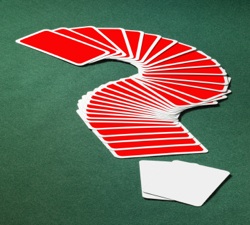A magazine where the digital world meets the real world.
On the web
- Home
- Browse by date
- Browse by topic
- Enter the maze
- Follow our blog
- Follow us on Twitter
- Resources for teachers
- Subscribe
In print
What is cs4fn?
- About us
- Contact us
- Partners
- Privacy and cookies
- Copyright and contributions
- Links to other fun sites
- Complete our questionnaire, give us feedback
Search:
The top flight magic trick

When we move from A to B, in a bus, a car or a plane, the fuel we burn releases carbon dioxide into the air and we leave what’s called a carbon footprint. This magical demonstration shows that simple playing cards can move without such eco-damage. In your demonstration you count out exactly 10 cards. You place five of them on one side of the room and the remaining 5 on the other. Then invisibly, and without any trace of CO2 one card travels from the first pile to the second. Have you really mastered powers of invisible, zero energy transportation, or is it all in the mind of your spectators? Here’s how this cunning bit of mind manipulation is possible.
Start with the convincer
Start with an ordinary pack of playing cards. In stage one you are going to do what magicians call the convincer. You are going to count out ten cards, but you do it in reverse. First card down, count 10. Next card is 9. Count out loud and clear: 8, 7, 6, 5, 4, 3, 2, 1. When you put the cards down do it with a slight spread of each card so the spectators can see it’s a fair count of 10 cards. It’s true, there are 10 cards on the table, and your spectators are now primed to believe that reverse counting is an accurate way to count cards. Pick up these ten cards, and put the rest of the pack aside.
A bit of sleight of mind
Now comes the sleight of mind. Like sleight of hand where magicians move cards in a sneaky way to fool their audience, you’re going to fool the spectators’ brains. You tell the spectators that you’re going to deal the ten cards into two piles of five, but again you’re preparing them for what’s to come. Into one pile you count from ten down to five (this time not spreading the cards in the pile). That’s half the cards right? You’ve got five undealt cards left too, ‘cause we all know 5+5 =10. The two separate piles, you remind your audience, have exactly five cards each. Now you make the magical, invisible flight of one card happen. Wave your hands or click your fingers. Perhaps you might even cover the two piles with a cloth and lay your hands on the top of the now hidden piles. Be creative and sell the effect. Sure enough, when your spectators count the cards in the piles, one pile has six cards, the other has four! Yipes! How did that happen?

Don’t believe it so far? Let’s examine the facts
If you’ve read the description so far, which is entirely true, and still think it’s impossible, then you’re making exactly the same mistake you’re hoping your spectators will. Of course, you’re being fooled by the words only, but they will be fooled by your actions too.
Rewind – where is the ‘magic’? The convincer says that if you count back from ten to one, you have ten cards. That’s true in this case. Now look again at the instructions: the first pile of ‘five’ cards is also created by reverse counting, starting with the ten cards, but counting from ten to five. Let’s run that again. 10, 9, 8, 7, 6, 5. Now count the actual number of cards – it’s actually six! So all that’s left for the second pile is four cards. Trick done. Two piles of five are actually one pile of 6 (due to the reverse count) and one pile of four (‘cause that’s what’s left over) – the rest is presentation. So what’s going on in the minds of you and your spectators?
Counting on a cognitive slip
What’s happening here is called a cognitive slip. Human brains love to find patterns, and once they have a pattern that’s comfortable they sort of take a break. What happened before will probably happen again, they think. After all our brains are busy all the time, so they have to use some shortcuts to save on processing power. An action repeated that looks like the previous action is treated much the same. This is called a capture error. When you do the convincer, reverse counting from ten to one gives ten cards, (spreading the cards helps to fix this in people’s minds), and the pattern is established. Now, when the ten-to-five reverse count of the first pile happens, the idea you established, that reverse counting is correct, takes over from the arithmetic reality that 10 - 6 = 4. It’s so easy to be tricked: we all know from way back that 5 + 5 = 10, the reverse count went from ten to five, then you say there are two piles of five, and our brains are fooled.

Work that memory
You may be able to make the effect more effective using presentation that takes into account what researchers have discovered about slip errors.
People are more likely to make this kind of error if they have lots to think about – if you fill up the part of our memory used for short-term things. When you try and remember a telephone number off the TV for the few moments before you dial it – perhaps to vote on the X factor – then you are using this short-term “working memory”. If you tell people a story around the trick then you will be filling their working memory a little so perhaps the effect of the trick will be stronger.
It may also help if you do things like cover the cards with a cloth, as that gives them more to think about: more possible points that you might be pulling a fast one. It also adds some time misdirection – you could spin it out more by getting two people out to put there hands on the cards while staring into each others eyes to “make the psychic link”. Mention they need to concentrate as its dangerous and you wouldn’t want it to go wrong and them lose their hands!
That delay means the audience have to wait before they can try and work out when they were fooled as they don’t know what to look for. They are also then more likely to have forgotten what actually happened.
The Science of Magic
Perhaps 10 isn’t the best number of cards to use. Would counting down out 16 or 20 cards work better? Who knows? It turns out that people can take in how many of small numbers of objects there are without consciously counting them. Place four cards on the table and people can see instantly how many there are. Five is harder. More than that and most people would need to count them. Of course you are putting the cards in a neat pile so they can’t be seen, but perhaps by only laying down 5 cards you are making it too easy to spot what is going on. Why not turn yourself into a scientist. Do some experiments with the trick to find out, trying different numbers and seeing which fools most people.
Preventing slips of the mind
Understanding how people process information, and more importantly why they make mistakes, is vital to developing safe and easy to use software. In this case the human error leads to a magical transport of a card, but imagine if your software allowed the users to make a similar mistake in a medical application. The amount of a particular life-saving drug your system will pump into a patient is now 6 units rather than the 5 you wanted. That’s not magical. It’s possibly lethal. Computer science researchers are trying to build mathematical descriptions of how and why we make mistakes. This research into the workings of human error holds the prospect of making safer software in the future. Software designed so that people make fewer errors using it. After all good software, like this magic trick, depends on understanding the way the human mind works to produce the effect that’s wanted.


